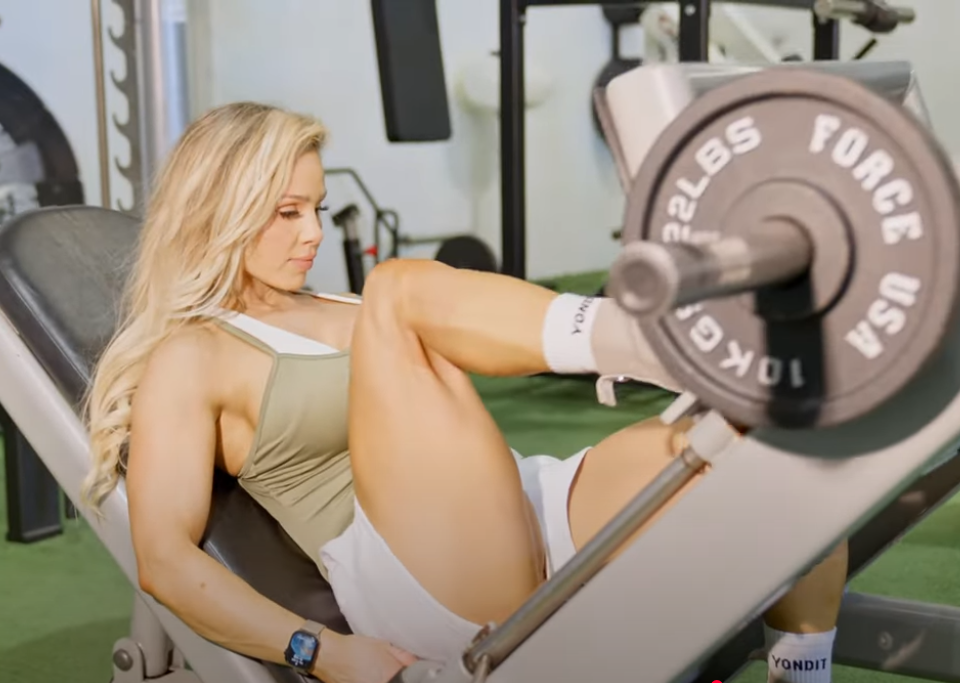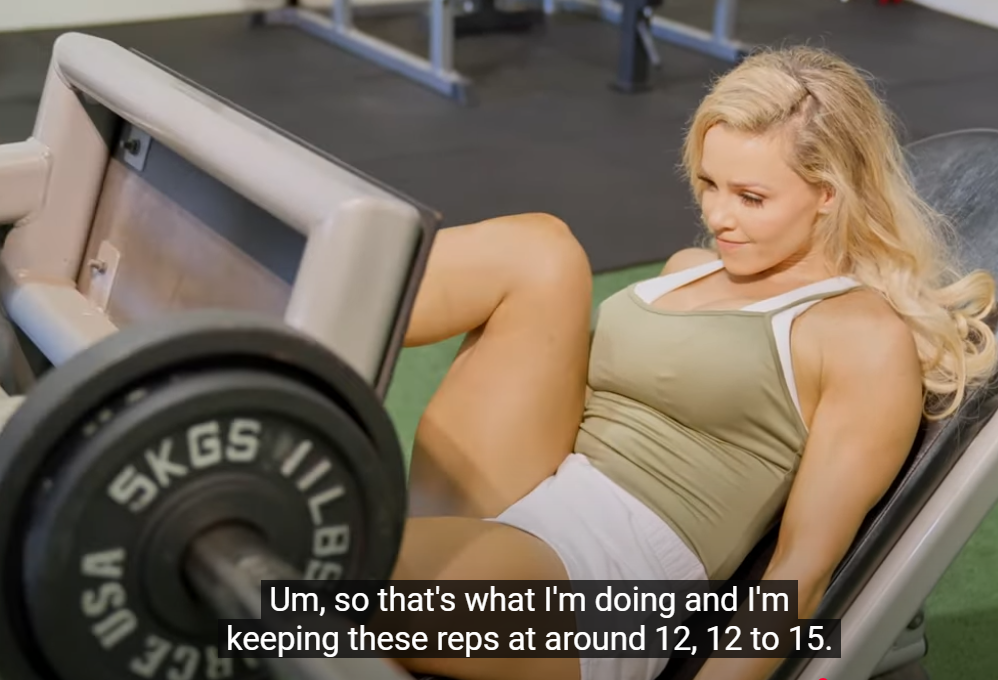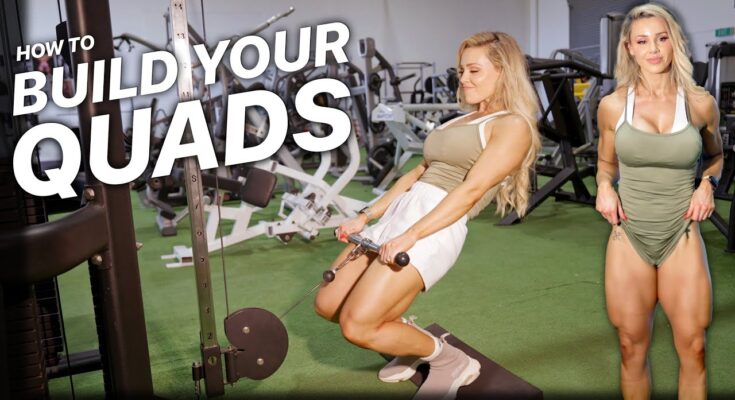1. Prioritize Squats (The Right Way)
Squats are the king of leg exercises, and if you’re not squatting, you’re leaving serious quad gains on the table. But the way you squat matters.
- Front squats shift the load more toward your quads than back squats.
- Keep your torso upright and knees over your toes for maximum quad activation.
- Don’t shy away from deep squats—just make sure your mobility allows it.
Tip: Start your leg day with squats to hit the quads when you’re strongest and freshest.

2. Use the Hack Squat Machine
The hack squat machine is a quad-dominant powerhouse. It allows you to isolate the quads while minimizing lower back strain.
- Keep your feet low on the platform to emphasize quads.
- Control the eccentric (lowering) portion for a better stretch.
- Go deep—this movement lets you safely train through a full range of motion.
Pro move for 2025: Try using resistance bands or chains to alter the resistance curve and overload the quads at different points in the rep.
3. Train Quads 2x per Week
If you only hit quads once a week, you’re limiting growth potential. A twice-weekly approach gives you more training volume and more chances to improve.
Example split:
- Day 1 (Heavy quad focus): Back squats, hack squats, walking lunges
- Day 4 (Isolation focus): Leg extensions, Bulgarian split squats, sissy squats
Allow at least 48–72 hours between sessions to recover and grow.

4. Add Leg Extensions—But Do Them Right
Leg extensions isolate the quads and give a killer pump. But form is key:
- Don’t swing the weight—control each rep.
- Pause at the top and squeeze the quads.
- Lower slowly to keep tension on the muscle.
For 2025: Try single-leg extensions or vary the rep tempo to challenge your quads in new ways.
5. Experiment with Tempo Training
Changing the speed of your reps can drastically increase time under tension—a key factor for muscle growth.
Try this tempo scheme for squats or leg presses:
- 3-second eccentric (lowering)
- 1-second pause at the bottom
- Explosive concentric (lifting)
- No pause at the top
Tempo training increases intensity without needing super heavy weights, making it joint-friendly too.

6. Use Blood Flow Restriction (BFR) Training
BFR training involves using wraps or cuffs to restrict blood flow to the muscles. It allows for big muscle activation with lighter weights—perfect for quad finishers.
Try:
- Leg extensions with BFR bands (20-30% of your usual weight)
- 3–4 sets of 15–30 reps with short rest periods
This method promotes hypertrophy with minimal joint stress, making it ideal for longevity in training.

7. Bulgarian Split Squats: Love Them or Hate Them
They’re brutal, but they work. Bulgarian split squats are one of the most effective unilateral exercises for quads.
- Elevate your back foot on a bench.
- Keep your chest tall and front shin vertical.
- Drop your back knee toward the floor and push through your front heel.
Advanced twist: Try them with a safety bar or dumbbells to challenge stability and control.
8. Train Through Full Range of Motion
Half-reps = half gains. To fully develop the quads, you need to stretch and contract the muscle through its entire range.
This means:
- Go below parallel on squats (if safe and mobile).
- Use deep lunges and step-ups.
- Control both the lowering and lifting phase of every rep.
More stretch = more muscle fiber recruitment = more growth.

9. Fuel for Growth: Don’t Skip Carbs
Quads are big muscles, and they need serious fuel to grow. In 2025, we know more than ever about how crucial proper nutrition is for hypertrophy.
- Carbs before training give you the energy for heavy lifts.
- Protein after training helps repair and grow muscle.
- Don’t shy away from healthy fats—they support hormone production.
Aim for a calorie surplus if your goal is size. No fuel, no growth.

10. Track Your Volume and Progression
In 2025, data is your training partner. Use an app or notebook to track:
- Exercises performed
- Sets, reps, and weights
- Rest times
- Weekly training volume
Progressive overload is the key to growth. If your numbers aren’t increasing over time, your quads won’t be either.

11. Improve Your Mobility
If your ankles, hips, or knees are tight, you won’t get full range in your squats or lunges—and your quads won’t be fully activated.
Daily mobility drills for the lower body can help:
- Ankle dorsiflexion stretches
- Hip openers and dynamic warm-ups
- Foam rolling your quads and IT bands
Better mobility = deeper squats = better quad activation.

12. Recover Like It’s Part of Your Program (Because It Is)
Training breaks down muscle; recovery builds it. In 2025, recovery tools are more accessible than ever—so use them.
- Get 7–9 hours of sleep nightly.
- Use compression boots, massage guns, or contrast therapy if available.
- Stretch and walk on rest days to keep blood flow high.
Recovery isn’t passive—it’s an active part of your training plan.
Final Thoughts
Growing your quads takes more than a few sets of leg presses once a week. It takes focused effort, smart programming, good nutrition, and consistency. The tools and knowledge we have in 2025 make it easier than ever to get results—if you apply them.
Start with these 12 tips. Train hard, train smart, and don’t skip leg day. If you give your quads the attention they deserve, you’ll start seeing serious size, shape, and strength gains in no time.



